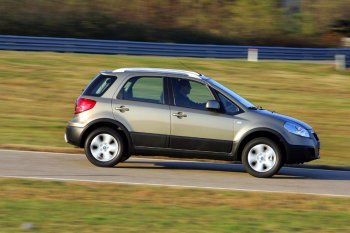|
FLEXIBLE
ENVIRONMENTALLY FRIENDLY ENGINES
|
|
The Fiat Sedici
is equipped with two engines (a 1.6 petrol and a 1.9
turbodiesel unit), both combined with five or six speed
manual gearboxes with precise shift and low load values. In
particular, the 120 bhp 1.9 8v Multijet unit ensures
outstanding power and torque values for low fuel consumption
under all driving conditions: a veritable gem of automotive
engineering that confirms Fiat Auto's leadership in this
field. Development of the Multijet system has also allowed
the Fiat Group to achieve an important new record in the
diesel engine field. The Fiat Sedici Multijet engine meets
Euro 4 standards and is fitted as standard with a
particulate trap (DPF) that lowers fine powder pollution.
This for life system does not require the use of additives
for regeneration and also attracts tax benefits. When fitted
with this engine, the new model can also be driven freely
through areas where traffic is restricted for environmental
reasons.
120 bhp 1.9 Multijet
The unit is a 4 cylinder in line engine - two valves per
cylinder - with a bore of 82 millimetres and a stroke of
90.4 mm, capable of delivering a power output of 120 bhp (88
kW) at 4000 rpm and a torque of 280 Nm (28.6 kgm) at 2000
rpm. The power unit has undergone several engineering
changes to increase performance and engine torque at low
speeds and to reduce noise and vibration levels. The 120 bhp
1.9 Multijet unit is turbocharged via an
electronically-controlled turbocharger with variable
geometry turbine that helps improve power delivery while
also allowing very high torque delivery even at low rpms.
Suffice it to say that 90% of maximum torque is available
between 1750 and 3250 rpm. These data translate into great
driving satisfaction and hot performance. The 1.9 Multijet
engine also meets Euro 4 standards due to its EGR emission
control system that includes an electrically-operated valve
managed directly by the engine control system, a heat
exchanger for cooling recirculated exhaust gases and a close
coupled catalytic converter. The presence of a particulate
trap DPF (Diesel Particulate Filter) also contributes to the
green nature of this engine. This mechanical filter is
installed in the exhaust system and physically traps the
carbon particles present in the Diesel engine exhaust gas.
During normal service, the engine control unit records a set
of data (service period, route type, temperature reached)
and calculates the amount of particulate that has built up
in the filter. Because the trap is an accumulation system,
it must be regenerated regularly (cleaned) by burning the
carbon particles. The engine control unit manages the
regeneration process automatically according to the amount
of carbon that has accumulated in the filter and vehicle
service conditions: all this without the need for additives
and without requiring any particular maintenance operations.
The Multijet system fitted to second generation JTD
engines.
The underlying principles of second generation turbodiesel
engines remain the same, i.e. high injection pressure and
electronic injector control. But one extra feature has been
added: during each engine cycle, the number of injections
increases over and above the current number of two. In this
way, the same amount of diesel is burnt inside the cylinder
but in several portions to achieve smoother combustion. The
advantages include lower running noise, reduced emissions
and a 6-7% increase in performance. All this comes with a
level of engine efficiency that improves car handling still
further. These results are not to be underestimated,
particularly because they are obtained with an engine that
represents an incredible leap forward from prechamber
diesels and even improves on first generation JTD engines.
The secret of the Multijet engine lies in the control unit
that governs the electric injector opening and closure
system (and also in the injectors themselves).
|
 |
|
 |
|
The crucial part of the engine is the electronic control
unit itself, due to its ability to deliver a series of very
closely-spaced injections. Fiat Auto's researchers developed
the part (together with the injectors) especially for this
application. It is designed to deliver the multiple
injections that assure the designer more accurate control of
pressures and temperatures developed inside the combustion
chamber and also more efficient use of air taken into the
cylinders. This enables further goals to be achieved:
quieter combustion, reduced emissions and increased
performance.
The Multijet system is underpinned by long years of
research. Our engineers began by resolving the problem of
limits imposed by the control units. Then they went on to
map the benefits they could achieve by plotting different
multiple injection sequences (two secondary injections very
close to the main injection; one secondary injection not too
close to the main injection plus two closely-spaced
secondary injections; one secondary injection and then two
main injections close together after a certain period etc.)
against different engine service conditions: in the idling
region; with low loads and low rpm; with high rpm and
moderate load; with low rpm and high load etc. The study
revealed the potential of the system and showed that great
benefits are achievable in all cases, though these tend to
focus on one field or another according to the type of
sequence chosen and the engine service area targeted. In
some cases, for example, the priority is to reduce start-up
times and fume levels, in other cases it is to increase
torque and reduce noise while in others it is to reduce
emissions and ensure a quieter drive. This research led to
the production of Multijet engines, including the 120 bhp
1.9 Multijet 8v unit fitted to the Fiat Sedici.
79 kW 1.6 16 valve (107 bhp)
The Fiat Sedici may be equipped with a powerful and flexible
1600 cc petrol engine: this is a 4 cylinder inline unit with
a bore of 78 millimetres and stroke of 83 mm (four valve per
cylinder) that develops a power output of 79 kW (107 bhp) at
5600 rpm. The new engine is ideal for town driving and
twisting roads and was developed with particular attention
to performance and fuel consumption. It owes its qualities
to a variable timing system that helps optimise torque and
power at any speed.
The new engine is also fitted with a VVT (Variable Valve
Timing) system that allows the intake and exhaust valve
timing to be varied. This system optimises cylinder filling
and also allows internal EGR (Exhaust Gas Recirculation) to
be implemented by making intake and exhaust valve opening
overlap for a considerable improvement in emission and
performance. This ensures combustion is more complete and
thus improves performance. For example, the more efficient
combustion allows better performance and increased torque at
low speeds: the maximum is 145 Nm (14.8 kgm) at 4000 rpm, to
benefit driving flexibility. A Fiat Sedici with this engine
can achieve a top speed of 170 km/h and the fuel consumption
figures are low: 8.9 l/100 km over an urban cycle, 6.1 l/100
km for an extra-urban cycle and 7.1 l/100 km over mixed
routes. In other words, a vigorous yet frugal engine. The
107 bhp 1.6 16v engine complements these performances with
respect for the environment, as evidenced by the low
emission values. |
|